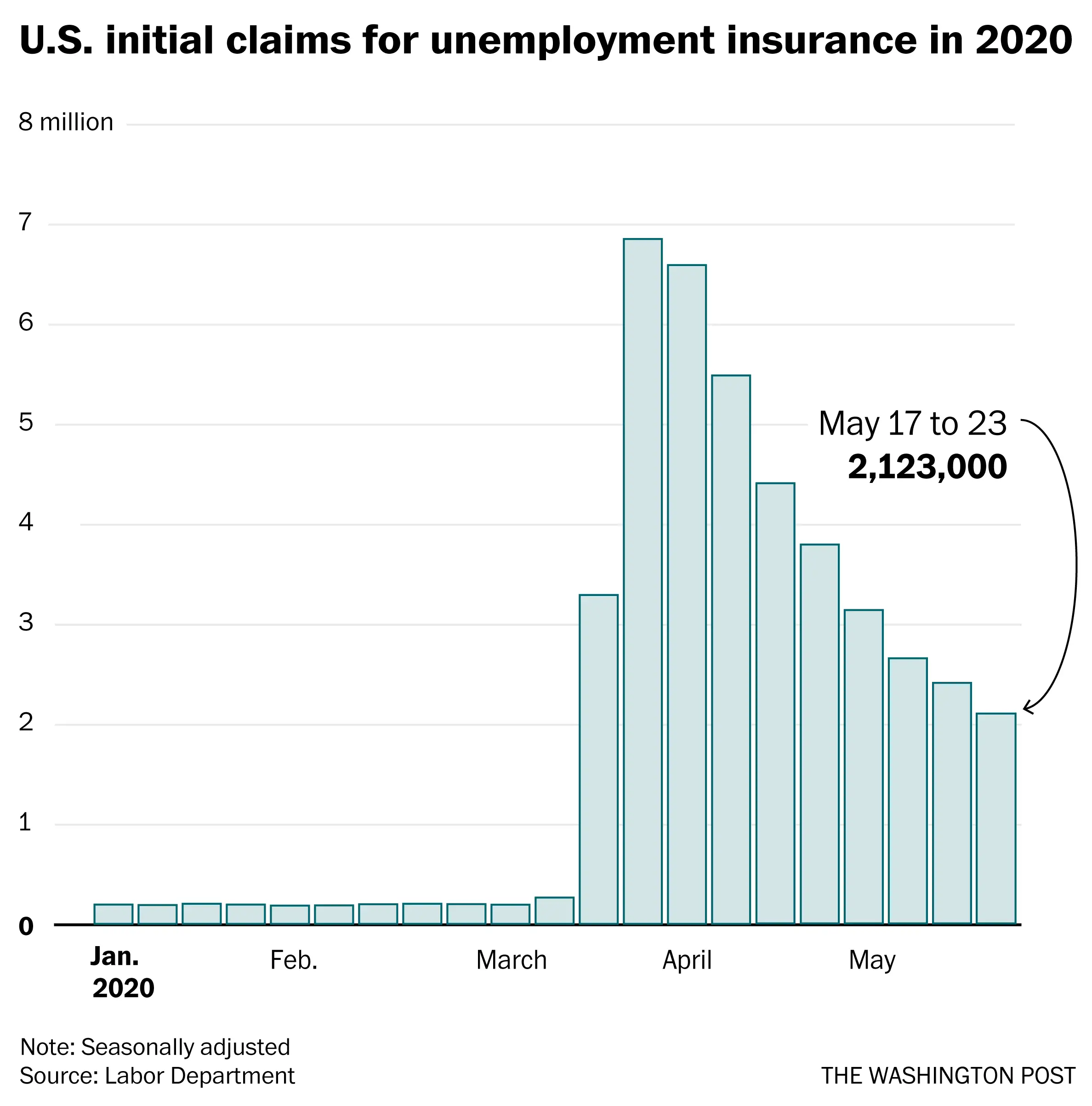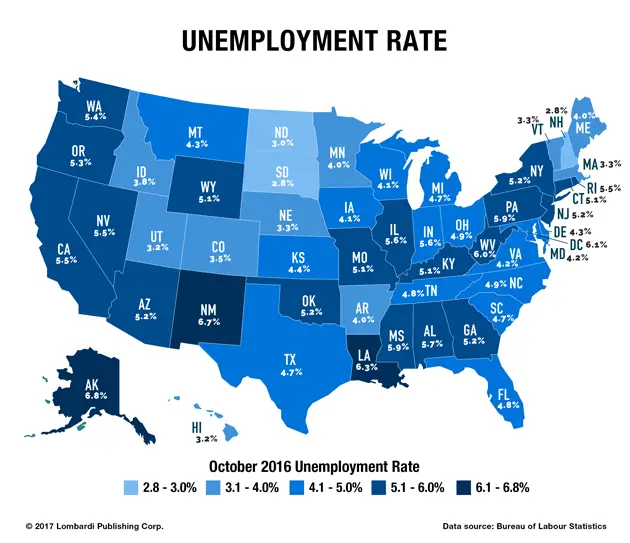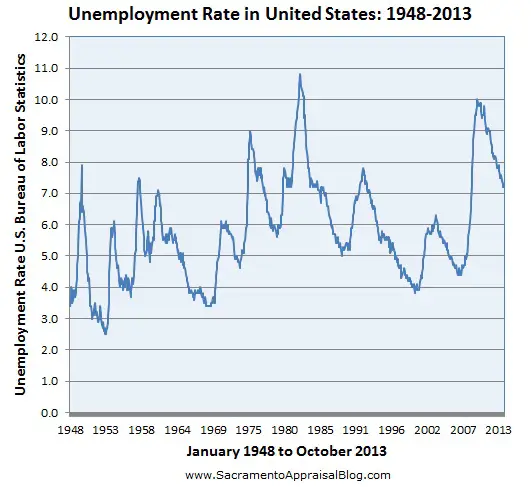Payment Through Prepaid Debit Cards
Most states deliver unemployment benefits to recipients who do not have a bank account through a prepaid debit card. The federal government uses the Direct Express Debit Mastercardprepaid debit card offered by Mastercard and Comerica Bank to give some federal assistance payments to people who do not have bank accounts. Many states have similar programs for unemployment payments and other assistance.
Unemployment Rate And Covid
In response to pandemic-related closures or business cutbacks, unemployment in the United States achieved historic records. In May 2020, 49.8 million individual reported they had been unable to work at some point in the prior four weeks because their employer closed or lost business due to the pandemic. The unemployment rate increased from 4.4% in March 2020 to 14.8% in April 2020, achieving levels not seen since the 1930s.
The impacts of COVID-19 were experienced across the nation, as every state in the United States experienced a higher unemployment rate than what was recorded during the Great Recession. However, unemployment rates disproportionally impacted different sectors:
- Financial Activities: The unemployment rate in May 2020 was 5.7%, while the unemployment rate in July 2021 had improved to 3.0%.
- Leisure and Hospitality: The unemployment rate in April 2020 was 39.3%, while the unemployment rate in July 2021 had improved to 9.0%.
- Wholesale and Retail: The unemployment rate in April 2020 was 17.1%, while the unemployment rate in July 2021 had improved to 6.0%.
A03 Nsa: Employment Unemployment And Economic Inactivity For Men Aged From 16 To 64 And Women Aged From 16 To 59
Employment, unemployment and economic inactivity for men aged from 16 to 64 and women aged from 16 to 59 . The employment and inactivity rates shown in this table were the headline employment and inactivity rates until August 2010, when ONS replaced these headline rates with rates for those aged from 16 to 64 for both men and women. These new headline rates for those aged from 16 to 64 are shown in Table A02 NSA. These estimates are sourced from the Labour Force Survey, a survey of households.
Also Check: How Do I Sign Up For Unemployment In Tn
The Role Of Labour Market Policy And Institutions
The role of labour market policy and institutions varies a lot from countries to countries. Here is a brief account of key propositions recently elaborated to facilitate access to employment for youth. First, a more balanced employment protection for permanent and temporary workers is needed. It will ensure that young people who lack work experience can prove their abilities and skills to then progressively transition to regular employment. It will also encourage a more equal treatment between permanent and temporary workers and help combat informal employment. This proposition has led to multiple discussions on flexible contracts to be designed and offered to youth. Second, discussions are focused on the level and spread of income support provided to unemployed youth. While some countries consider shifting their support from direct financial assistance to funding apprenticeship, others are increasing their support tying it back to stricter obligations of active search and training. Third, Governments are progressively involving employers and trainers to create a holistic approach to youth unemployment and provide intensive programmes with focus on remedial education, work experience and adult mentoring.
How To Use The Unemployment Rate

Keep in mind that the unemployment rate is a lagging indicator. It tells you what has already happened, since employers only lay off workers after business slows down.
Companies resist hiring new workers when a recession is over, until they can be sure that the economy will stay strong. The economy could improve for months, and the recession could be over before the unemployment rate drops. It’s not suitable for predicting trends, but it’s useful for confirming them.
Don’t Miss: How To Get Unemployment Check Stubs
What The Us Unemployment Rate Doesnt Tell You
The true measure of unemployment depends on who you ask
Just how healthy is the US jobs market? On Friday, the Bureau of Labor Statistics released its latest jobs report, showing that the US added a disappointing 194,000 jobs last month while announcing that the official unemployment rate fell to 4.8%, the lowest its been since its frightening climb to 14.7% when the Covid-19 pandemic first struck the US.
The figures seem somehow disconnected and, for some, Septembers headline figure is woefully misleading, as it is every month. What if the true unemployment rate is actually closer to 22%?
Us Youth Unemployment Rate 1991
- U.S. youth unemployment rate for 2021 was 9.57%, a 5.28% decline from 2020.
- U.S. youth unemployment rate for 2020 was 14.85%, a 6.51% increase from 2019.
- U.S. youth unemployment rate for 2019 was 8.34%, a 0.24% decline from 2018.
- U.S. youth unemployment rate for 2018 was 8.58%, a 0.63% decline from 2017.
| U.S. Youth Unemployment Rate Historical Data |
|---|
| Year |
Don’t Miss: Does Workers Comp Count As Income For Unemployment
Exhibit : Texas Average Annual Labor Force Participation Rates By Demographic Group 2003 And 2015 2015 Texas Ranking Among All Us States
| Demographic Groups | |
|---|---|
| -4.4% | 27 |
* Preliminary estimates for 2015. Due to sampling size, only 43 states and Washington, D.C. are included in the Black/African American population sample.
Thus most analyses of declining labor force participation suggest that its due largely to long-term demographic and societal shifts, with only a relatively small part due to discouraged workers and lingering weakness in the economy. Policymakers at all levels, however, should be aware of the participation rate, and the insights it can give us about how employment responds to economic conditions.
For more information on employment and unemployment statistics, visit the U.S. Bureau of Labor Statistics at bls.gov. FN
Alternative Measures Of Unemployment
In response to concerns that the official rate does not fully convey the health of the labor market, the BLS publishes five alternative measures: U-1, U-2, U-4, U-5, and U-6. Though these are often referred to as unemployment rates , U-3 is technically the only official unemployment rate. The others are measures of “labor underutilization.”
Also Check: How To File For Unemployment In Alabama
What The Current Unemployment Rate Means For You
When businesses are hiring, wages rise and fewer people are unemployed. Thats seemingly good news for you and your wallet. But that might not necessarily be the case.
Because there are so few unemployed people, employers have to compete even harder to attract employees and get staffed up. That means pay risesbut inflation comes along for the ride. Inflation is makes gas, groceries, and nearly anything else you want to buy way more expensive.
New Hampshire Unemployment Rate
New Hampshire has a long history as a manufacturing state, specifically with the production of paper and grain. As the use of mills began to decline over the 20th century, the Granite State turned to more traditional manufacturing. Although modern manufacturing has become far more high-tech, it still remains the biggest sector of New Hampshireâs economy.
- Unemployment Historic High/Low:
You May Like: Can I File For Unemployment While Waiting For Disability
Don’t Miss: Has Turbotax Updated For The Unemployment Tax Break
Chart Of The Day: The Real Unemployment Rate
Fridays unemployment rate of 5.2% for August is probably an undercount of the number of out-of-work people in the United States.
Under the Bureau of Labor Statistics way of measuring unemployment, those who are out of work and no longer looking for a job are not counted as unemployed, so they do not count in the headline rate. But many of those workers would in fact welcome the chance to work, and the bureau does track them.
When those workers are included, that rate, which we call the real unemployment rate, is 8.4%. And with federal Pandemic Unemployment Assistance set to expire on Sept. 6, that will only add more pressure on those out of work.
When those who are not in the labor force but want a job are included, the real unemployment rate is 8.4%.
Another measure of the jobless rate, the U6 underemployment rate, counts those who are only marginally attached to the labor force and are insufficiently employed. That figure stands at 8.8%, according to the bureau.
In our estimation, the decision to eliminate the additional federal benefits was made in haste, and in retrospect was a policy error. Too many assumed that the pandemic was over. Now, with the pandemic resurgent, this is not the time for reduced jobless benefits as hiring slows.
Whats clear is that the discouraging 235,000-job increase in August, down from an upwardly revised 1.053 million increase in July, highlights the enormity of the task ahead of us.
What The Real Unemployment Rate Means For You

The real unemployment rate includes several categories the U-3 unemployment does not: underemployed people, marginally attached workers, and discouraged workers.
Underemployed people are part-time workers who would prefer full-time jobs. The U-3 report counts them as being employed and in the labor force.
Marginally attached workers have looked for jobs in the last year, but not in the previous four weeks, which means they aren’t counted in U-3. They’re not included in the labor force participation rate, either.
Discouraged workers are marginally attached workers who aren’t looking for work because they believe they can’t qualify for available jobs, or because the don’t believe there are any available jobs.
Keeping an eye on the real unemployment rate can give you a broader picture of the current employment situation, which may influence your own employment or career decisions.
Don’t Miss: Where To Sign Up For Unemployment Benefits
The Unemployment Rate Was 37% In November 2022
Kimberly Amadeo is an expert on U.S. and world economies and investing, with over 20 years of experience in economic analysis and business strategy. She is the President of the economic website World Money Watch. As a writer for The Balance, Kimberly provides insight on the state of the present-day economy, as well as past events that have had a lasting impact.
Halfpoint Images / Getty Images
The current unemployment rate, which measures the percentage of workers who want a job but dont have one, has remained low as the U.S. economy continues to rebound from COVID-19.
The Bureau of Labor Statistics tracks unemployment and jobs on a monthly basis. The current unemployment rate reveals more about the state of the overall economy and its impact on the average American’s finances.
Exhibit : Texas Monthly Labor Force Participation Rate January 1976
Roll over the chart for specific values.
Texas 2015 average annual participation rate was 63.6 percent, ranking 27th among states . While Texas men ranked 13th among states, with a rate of 72.2 percent, the womens rate fell in the bottom half of states, at 55.4 percent.
Texas experienced similar declines across demographic groups as the U.S., while experiencing a similar uptick among the labor force aged 65 and older.
Also Check: Can You Have An Llc And Collect Unemployment
Many Workers Remained Sidelined With Job Losses Concentrated In Low
The unemployment rate jumped in April 2020 to a level not seen since the 1930s and stood at 4.9 percent in October 2021, compared with 3.5 percent in February 2020. That official unemployment rate, moreover, understated job losses.
There were still 4.2 million fewer jobs in October 2021 than in February 2020. The majority of jobs lost in the crisis have been in industries that pay low average wages, with the lowest-paying industries accounting for 30 percent of all jobs but 59 percent of the jobs lost from February 2020 to October 2021, according to Labor Department employment data. Jobs were down nearly twice as much in low-paying industries as in medium-wage industries and roughly 15 times as much as in high-wage industries during this period.
Black and Latino workers have experienced a far slower jobs recovery than white workers reflecting historical patterns rooted in structural racism. Some 7.9 percent of Black workers and 5.9 percent of Latino workers were unemployed in October 2021, compared to 4.0 percent of white workers. Workers who were born outside the U.S. have experienced larger job losses than U.S.-born workers.
Data from the Census Bureaus basic monthly Current Population Survey released November 10, 2021, provided more detail on unemployed workers and their family members. Some 17.9 million people either met the official definition of unemployed or lived with an unemployed family member in October. This figure included 4.4 million children.
How Unemployment Tracks Recessions
Unemployment tracks the business cycle. Recessions are part of that cycle and can cause high unemployment. Businesses often lay off workers and, without an income, those jobless workers have less money to spend. Lower consumer spending reduces business revenue, which forces companies to cut more payroll. This downward cycle can be devastating to individuals and the economy.
The highest rate of U.S. unemployment was 24.9% in 1933, during the Great Depression. Unemployment remained above 14% from 1931 to 1940. It remained in the single digits until September 1982 when it reached 10.1%. During the Great Recession, unemployment reached 10% in October 2009. In 2020, it reached double digits again at 14.7% in April when the U.S. was dealing with a pandemic and recession.
The Federal Reserve uses expansionary monetary policy to lower interest rates. Congress uses fiscal policy to create jobs and provide extended unemployment benefits.
The unemployment rate typically falls during the expansion phase of the business cycle. The lowest unemployment rate in modern history was 1.2% in 1944.
Also Check: How Do You Collect Unemployment
An Uneven Economic Recovery
Interpreting the employment situation during the COVID-19 pandemic has been especially complicated, according to Willie Powell, a research associate with the Harvard Kennedy School. Powell and others pointed out a major discrepancy in BLS reporting in key months during 2020 and 2021, which resulted in an artificially low jobless rate. Millions of workers on temporary layoff or furlough were misclassified as employed but “absent from work for other reasons,” except a large percentage of them should have been counted as unemployed.
Plus, as a result of stay-at-home orders and shuttered schools and services, there was an unusually large and rapid reduction in the workforce. What further impacted numbers was that many older workers retired earlier than expected due to the pandemic, dragging down labor force participation. Women also exited the labor pool at high rates due to the increased burden of childcare and eldercare responsibilities. Many industries, and individuals, haven’t yet bounced back.
“If you’re confused about what the economy is doing right now, it’s just because it’s confusing,” Powell said.
What is clear, however, is that the pandemic-related recession both reflected and reinforced economic inequality. According to a by the Hamilton Project, COVID-19 exacerbated racial and gender gaps, with job losses disproportionately impacting Black people, Latinos, women and lower-wage earners.
Us Unemployment Rates By Year
The U.S. Bureau of Labor Statistics has measured unemployment since the stock market crash of 1929.
Gross domestic product is the measure of economic output by a country. When the unemployment rate is high, there are fewer workers. That could lead to less economic output and a lower rate of GDP.
When inflation rises, the prices of goods and services go up, making them more expensive. If there is a high rate of unemployment at the same time, this could cause issues for those without an income since they may be struggling to afford basic necessities.
The following table shows how unemployment, GDP, and inflation have changed by year since 1929. Unless otherwise stated, the unemployment rate is for December of that year. Unemployment rates for the years 1929 through 1947 were calculated from a different BLS source due to current BLS data only going back to 1948. GDP is the annual rate and inflation is for December of that year and is the year-over-year rate.
| Year |
|---|
Also Check: How To Get My W2 From Ny Unemployment
Exhibit : Us Monthly Labor Force Participation Rates Total And By Sex January 1948
Roll over the chart for specific values.
Participation rates among the prime 25- to 54-year-old age group also have fallen . The age groups participation peaked in January 1999 at 84.6 percent, and slumped to 80.6 percent in September 2015. Its February rate was 81.1 percent.
The most dramatic decline in labor force participation has been among the young. The LFPR for those aged 16 to 19 peaked in 1978, at nearly 60 percent. Since then it has fallen precipitously, hitting a low of 32.7 percent in February 2014. The 20- to 24-year-old age group also has declined steadily, from a peak of nearly 80 percent in 1987 to 69.5 percent during 2015. This trend is due, at least in part, to the increasing share of this group that chooses to pursue higher education.
Conversely, participation rates among those aged 55 and above have risen, due to reasons such as longer life expectancy and changing attitudes toward retirement . This rate has risen from a low of 29.2 percent in 1993 to about 40 percent since 2010.
Demographics And Employment Trends

Employment trends can be analyzed by any number of demographic factors individually or in combination, such as age, gender, educational attainment, and race. A major trend underlying the analysis of employment numbers is the aging of the white workforce, which is roughly 70% of the employment total by race as of November 2016. For example, the prime working age white population declined by 4.8 million between December 2007 and November 2016, roughly 5%, while non-white populations are increasing. This is a major reason why non-white and foreign-born workers are increasing their share of the employed. However, white prime-age workers have also had larger declines in labor force participation than some non-white groups, for reasons not entirely clear. Such changes may have important political implications.
Also Check: How Much Taxes Do You Pay On Unemployment